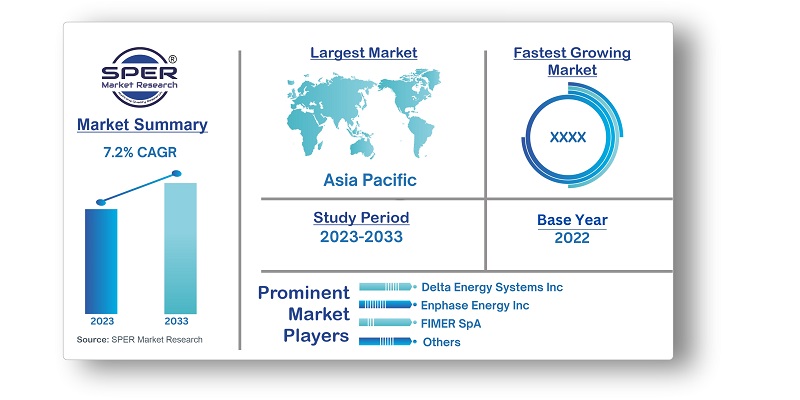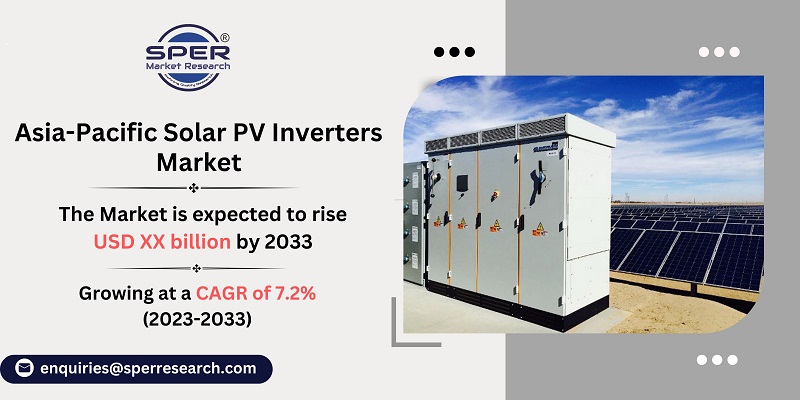
Asia Pacific Solar PV Inverter Market Growth, Size, Trends, Demand, Revenue and Future Outlook
Asia Pacific Solar PV Inverter Market Size- By Inverter Type, By Application- Regional Outlook, Competitive Strategies and Segment Forecast to 2033
| Published: Jan-2024 | Report ID: POAE2404 | Pages: 1 - 157 | Formats*: |
| Category : Power & Energy | |||
- May 2022: An 18 MWh battery energy storage system in Gujarat, India, was equipped with a solar-plus-storage project that received 1 Mega Volt Ampere (MVA) inverters from FIMER SpA, an Italian solar PV inverter manufacturer. The project is situated in Modhera and is known as the Integrated Solar Energy Project. The state's utility, Gujarat Power Corporation Limited (GPCL), awarded the project to Mahindra Susten Pvt. Ltd, an Indian solar PV engineering, procurement, and construction (EPC) solution provider.
- April 2022: Solar Electric Vietnam Joint Stock Company and Sungrow, a producer of PV inverter solutions, inked a new 50 MW sales agreement. With this contract, Solar Electric became Sungrow's long-term strategic partner in Vietnam, further solidifying the two companies' cooperation.


| Report Metric | Details |
| Market size available for years | 2019-2033 |
| Base year considered | 2022 |
| Forecast period | 2023-2033 |
| Segments covered | By Inverter Type, By Application |
| Regions covered | China, India, Japan, South Korea, Australia and New Zealand, Indonesia, Thailand, Malaysia, Vietnam, Philippines, Singapore, Rest of Asia-Pacific |
| Companies Covered | Delta Energy Systems Inc., Enphase Energy Inc., FIMER SpA, General Electric Company, Genus Innovation Limited, Huawei Technologies Co. Ltd, Mitsubishi Electric Corporation, Omron Corporation, Schneider Electric SE, SMA Solar Technology AG. |
- Solar Energy Developers and Installers
- Investors and Financial Institutions
- Manufacturers and Suppliers
- End Users
| By Inverter Type: |
|
| By Application: |
|
| By Region: |
|
- Asia-Pacific Solar PV Inverter Market Size (FY’2023-FY’2033)
- Overview of Asia-Pacific Solar PV Inverter Market
- Segmentation of Asia-Pacific Solar PV Inverter Market By Inverter Type (Central Investors, String Inverters, Micro Inverters)
- Segmentation of Asia-Pacific Solar PV Inverter Market By Application (Residential, Commercial and Industrial, Utility-scale)
- Expansion Analysis of Asia-Pacific Solar PV Inverter Market
- Problems and Obstacles in Asia-Pacific Solar PV Inverter Market
- Competitive Landscape in the Asia-Pacific Solar PV Inverter Market
- Impact of COVID-19 and Demonetization on Asia-Pacific Solar PV Inverter Market
- Details on Current Investment in Asia-Pacific Solar PV Inverter Market
- Competitive Analysis of Asia-Pacific Solar PV Inverter Market
- Prominent Players in the Asia-Pacific Solar PV Inverter Market
- SWOT Analysis of Asia-Pacific Solar PV Inverter Market
- Asia-Pacific Solar PV Inverter Market Future Outlook and Projections (FY’2023-FY’2033)
- Recommendations from Analyst
1.1. Scope of the report1.2. Market segment analysis
2.1. Research data source2.1.1. Secondary Data2.1.2. Primary Data2.1.3. SPER’s internal database2.1.4. Premium insight from KOL’s2.2. Market size estimation2.2.1. Top-down and Bottom-up approach2.3. Data triangulation
4.1. Driver, Restraint, Opportunity and Challenges analysis4.1.1. Drivers4.1.2. Restraints4.1.3. Opportunities4.1.4. Challenges4.2. COVID-19 Impacts of the Asia-Pacific Solar PV Inverter Market
5.1. SWOT Analysis5.1.1. Strengths5.1.2. Weaknesses5.1.3. Opportunities5.1.4. Threats5.2. PESTEL Analysis5.2.1. Political Landscape5.2.2. Economic Landscape5.2.3. Social Landscape5.2.4. Technological Landscape5.2.5. Environmental Landscape5.2.6. Legal Landscape5.3. PORTER’s Five Forces5.3.1. Bargaining power of suppliers5.3.2. Bargaining power of buyers5.3.3. Threat of Substitute5.3.4. Threat of new entrant5.3.5. Competitive rivalry
5.4. Heat Map Analysis
6.1. Asia-Pacific Solar PV Inverter Market Manufacturing Base Distribution, Sales Area, Product Type6.2. Mergers & Acquisitions, Partnerships, Product Launch, and Collaboration in Asia-Pacific Solar PV Inverter Market
7.1. Asia-Pacific Solar PV Inverter Market Value Share and Forecast, By Inverter Type, 2023-20337.2. Central Investors7.3. String Inverters7.4. Micro Inverters
8.1. Asia-Pacific Solar PV Inverter Market Value Share and Forecast, By Application, 2023-20338.2. Residential8.3. Commercial and Industrial8.4. Utility-scale
9.1. Asia-Pacific Solar PV Inverter Market Size and Market Share
10.1. Asia-Pacific Solar PV Inverter Market Size and Market Share By Inverter Type (2019-2026)10.2. Asia-Pacific Solar PV Inverter Market Size and Market Share By Inverter Type (2027-2033)
11.1. Asia-Pacific Solar PV Inverter Market Size and Market Share By Application (2019-2026)11.2. Asia-Pacific Solar PV Inverter Market Size and Market Share By Application (2027-2033)
12.1. Asia-Pacific Solar PV Inverter Market Size and Market Share By Region (2019-2026)12.2. Asia-Pacific Solar PV Inverter Market Size and Market Share By Region (2027-2033)12.3. China12.4. India12.5. Japan12.6. South Korea12.7. Australia and New Zealand12.8. Indonesia12.9. Thailand12.10. Malaysia12.11. Vietnam12.12. Philippines12.13. Singapore12.14. Rest of Asia-Pacific
13.1. Delta Energy Systems Inc.13.1.1. Company details13.1.2. Financial outlook13.1.3. Product summary13.1.4. Recent developments13.2. Enphase Energy Inc.13.2.1. Company details13.2.2. Financial outlook13.2.3. Product summary13.2.4. Recent developments13.3. FIMER SpA13.3.1. Company details13.3.2. Financial outlook13.3.3. Product summary13.3.4. Recent developments13.4. General Electric Company13.4.1. Company details13.4.2. Financial outlook13.4.3. Product summary13.4.4. Recent developments13.5. Genus Innovation Limited13.5.1. Company details13.5.2. Financial outlook13.5.3. Product summary13.5.4. Recent developments13.6. Huawei Technologies Co. Ltd13.6.1. Company details13.6.2. Financial outlook13.6.3. Product summary13.6.4. Recent developments13.7. Mitsubishi Electric Corporation13.7.1. Company details13.7.2. Financial outlook13.7.3. Product summary13.7.4. Recent developments13.8. Omron Corporation13.8.1. Company details13.8.2. Financial outlook13.8.3. Product summary13.8.4. Recent developments13.9. Schneider Electric SE13.9.1. Company details13.9.2. Financial outlook13.9.3. Product summary13.9.4. Recent developments13.10. SMA Solar Technology AG13.10.1. Company details13.10.2. Financial outlook13.10.3. Product summary13.10.4. Recent developments
SPER Market Research’s methodology uses great emphasis on primary research to ensure that the market intelligence insights are up to date, reliable and accurate. Primary interviews are done with players involved in each phase of a supply chain to analyze the market forecasting. The secondary research method is used to help you fully understand how the future markets and the spending patterns look likes.
The report is based on in-depth qualitative and quantitative analysis of the Product Market. The quantitative analysis involves the application of various projection and sampling techniques. The qualitative analysis involves primary interviews, surveys, and vendor briefings. The data gathered as a result of these processes are validated through experts opinion. Our research methodology entails an ideal mixture of primary and secondary initiatives.



Frequently Asked Questions About This Report
PLACE AN ORDER
Year End Discount
Sample Report
Pre-Purchase Inquiry
NEED CUSTOMIZATION?
Request CustomizationCALL OR EMAIL US
100% Secure Payment






Related Reports
Our Global Clients
Our data-driven insights have influenced the strategy of 200+ reputed companies across the globe.




















